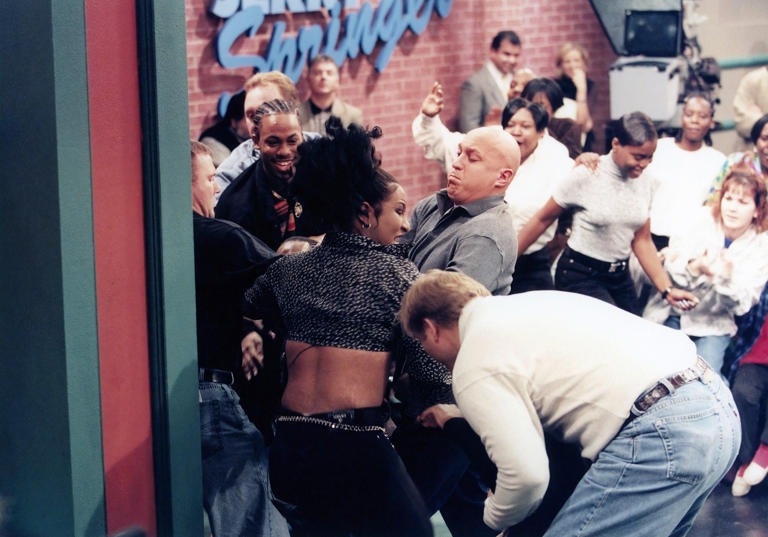Jerry Springer, TV’s master of trash,
and the world he left us
Story by Paul Farhi
Via MSN.com

Jerry Springer, TV’s master of trash, and the world he left us
© Ralf-Finn Hestoft/Corbis/Getty Images
When others went low, he went lower.
Jerry Springer never met a trashy setup he couldn’t milk for TV, in a genre he didn’t invent but certainly perfected. His was a kind of daytime reality/talk show, starring rabble and featuring the promise of mild violence.
Cheating spouse reveals. Baby daddy reveals. Teenage stripper reveals. Racists, badasses and brawlers. Springer, who died Thursday at 79, mined the depths and put what he dredged up on his show.
By the best possible reading — the absolute best — Springer’s self-named show was about the aggrieved, the wronged and the dispossessed, a grungy cohort that television had forever tried to ignore until his ilk came along.
In that sense, Springer’s endless circus of chaos — the show aired, somewhere, for 27 years — provided a kind of relief to viewers, some proof that their own troubles weren’t nearly as dreadful as those involved in the “Mad Max” spectacle unfolding before them. TV news has long done something similar.
Jerry Springer, whose tabloid talk show became a rowdy hit, dies at 79
But Springer came not to shed light on the lower depths of the human condition but to exploit it. Cheered on by a studio audience hungering for fireworks and fisticuffs — “Jer-ry! Jer-ry! Jer-ry!” — Springer was the ringmaster. His signature move, when the brawls invariably broke out and the muscled bouncers moved in to break them up, was to sigh, lower his head and drop his microphone.
The gesture, an insincere pantomime of resignation and regret, was symbolic of Springer’s cynicism and smarminess. “He brings the dry tinder and lights the match, but he’s always shocked, shocked, when a fire breaks out,” Slate’s David Plotz wrote in 1998.
By then, Springer was ascendant and unstoppable. His program had surpassed Oprah Winfrey’s daytime show in the ratings; he was the nasty to her nice. Before there was cancel culture, there was the kind of disapproval that only made Springer stronger. Two senators, Dan Coats (R-Ind.) and Joe Lieberman (D-Conn.), denounced the show as “the closest thing to pornography on broadcast television,” a statement that could only have prompted more viewers to drive past Springer’s multicar pileup.
“The Jerry Springer Show” now seems like a quaint forerunner of a far more astringent and amoral era of video mayhem. Soon there would be “bum” fights and bloody bare-knuckle street brawl videos sold over the counter. Soon there would be actual car wrecks on YouTube, deadly combat strikes, and all the detritus that a cellphone could collect and post on TikTok and Instagram, brawls breaking out in Walmarts, at neighborhood swimming pools, at traffic lights, everywhere. We live in the world Springer left us, no longer in need of a TV show with a set and an audience. We are the show. (Springer knew: We were always the show.)
The marvel of Springer is how far he traveled to become the king of television’s junk heap. The child of Holocaust survivors, he had been a lawyer, a political operative for Robert F. Kennedy and a member of Cincinnati’s city council, all by the age of 27. He lost his council seat after being convicted of soliciting a prostitute, but then regained it in the next election and went on to become the city’s appointed mayor (before direct elections) — significant achievements in an era when it was still difficult for the unserious to succeed in politics.
He then became the city’s most popular anchorman, winning multiple Emmys for his short commentaries.
His talk show, beginning in 1991, was at first a failure. Too serious. Too responsible and earnest. But the full tabloid Jerry, launched in 1994, was a breakthrough. Bland in appearance, with wire-rimmed glasses and tousled hair, Springer exuded an unthreatening, even professorial vibe, in stark contrast to the shock-fest he presided over.

Just another day in the life of “The Jerry Springer Show,” in 1991.© NBC/Courtesy Everett Collection
Springer’s swan dive into TV nihilism seems to have been inspired by another syndicated talk show of the time, hosted by Jenny Jones. When she, too, experienced sagging ratings, Jones dispensed with Oprah-like earnestness and ventured into more lurid subject matter. Bingo: out-of-control teens, strippers, neighbors with beefs against neighbors sent Jones’s viewership spiraling upward. The formula, however, went seriously awry in 1995 when Jones invited on a gay man, Scott Amedure, who confessed to a crush on another guest, Jonathan Schmitz, a co-worker. Schmitz was arrested three days after the taping and charged with Amedure’s murder.
Springer took Jones’s tabloid sensibilities and refined them like enriched uranium. He went beyond Jones, into “Mondo Cane-like” surprise and shock, complete with a full soundtrack of bleeped profanities and the satisfying sight of an occasional bloody nose.
Yes, there was a market for that on American TV. As much as anyone, Jer-ry! found it.
___
Jerry Springer, TV’s master of trash, and the world he left us
